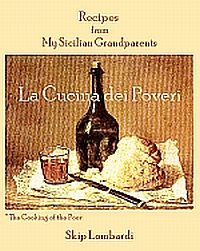Fish Story
August 25th, 2007Almost September, and the storms of summer have yet to arrive on the Sun Coast. True, our yards and the produce fields of Plant City and Ruskin need more rain, but we’d prefer that it be delivered by forces more benign than Dean, Erin, or their NOAA-named siblings.
Like it or not, we face two more months of official hurricane season. Though the Europeans’ favored month is August, there’s a reason so many Florida businesses and restaurants close during September, the middle of the five-month storm season.
Where do all the Sarasotans go? Those who don’t have homes back in Ohio, Indiana, and Michigan seem to favor North Carolina. Those who are truly en vacances, without second homes they feel compelled to use, may pack up their cars and drive through New England (lingering in Maine, in particular) and coastal Canada. We hear about those who cruise the Pacific Northwest… But the entire exodus is not to places cooler than Sarasota; many actually go through the indignities of airport security to travel to destinations just as warm, but DRY, where little rain falls from June through September and humidity is not the topic of everyday conversation.
It may be American travelers’ Euro-focus and the fact that Spain and Italy have provided so many place names to developers and city planners in Florida, that some forget about the other end of the Mediterranean. As cooks and diners, our September thoughts turn to the Mediterranean country with the longest coastline—where the dollar is still strong and simple restaurants’ “catch of the day” is literally that, not something that was trucked in overnight by Sysco.
In late summer and early fall, we think of Turkey—and fish, not fowl—caught in waters surrounding a largely peninsular nation lapped by the Mediterranean, Aegean, and Black Seas. Each body of water has different habitats that support different fish, crustaceans, and mollusks. And then there’s the Sea of Marmara, tucked between Istanbul’s Bosphorus Strait and the northern Aegean.
In Istanbul, September is the beginning of bluefish season. Though they may share the nomenclature of the fish so abundant in coastal New England, Turkish bluefish have a different diet, more delicate flavor, and are more highly esteemed than their over-caught American relatives. Istanbul has at least five different names for them, depending on their size. A few inches long, they are nicknamed defne or bay leaf. For fish 1—1/2 lbs, they are lufer, and then kofana for a fish that might serve five or six diners.
If you are not bluefishing off Nantucket or along other northern shores this summer, try this supremely simple grilling treatment on Florida kingfish, amberjack, bonito, or pompano.
You’ll need—
Whole fish, scaled and gutted, preferably no larger than 4 lbs. and as small as 1 lb. Those whose flesh or skin have a high oil content are best.
Florida white onions—sliced in 1/4 inch slices and separated into rings, tossed with coarsely ground black pepper and a little salt.
Bay leaves
Olive oil
Lemons or limes
As a guideline, for each pound of fish, you’ll need 3 bay leaves and 3—4 onion slices.
Fill each fish cavity with one layer of onion rings, some bay leaves, and 2-3 paper-thin slices of lemon or lime.
Brush or rub each fish with a little olive oil and place on a grill about 5 inches above coals that have developed a thin coating of ash.
You’ll want steady heat, but no direct flames, to slowly char the fish. When one side is nicely charred, turn over to do the other. 10-13 minutes should be enough time for a one-pound fish.
To serve: Remove the bay leaves, but keep the onions as edible garnish. If the flesh seems dry, drizzle a little more oil over the cooked flesh, and plate with citrus wedges.
Soon Turkey’s famous Black Sea hamsi, anchovies will appear in myriad dishes. In Turkey, anchovies are usually enjoyed fresh, though they can also be bought salt-cured or oil-packed. These little fish are eagerly awaited and show up as meze—filets in a cool vinegar bath or corn meal-dipped and deep-fried. As main dish elements, they are featured in rice pilav and baked between sheets of savory, flaky dough as borek. The fish are so closely associated with the northern coast of Turkey that Black Sea natives are themselves known as hamsi.
Perhaps the most irresistible hamsi presentation is similar to the bluefish recipe above—but the anchovies are first wrapped in grape-leaves and then grilled. The smoke from the singed grape leaves can’t be replicated with our abundant banana foliage. But the real problem with preparing grilled anchovies in Sarasota is: no fresh anchovies!
Sometimes one simply has to meet a dish on its home turf, or surf, as the case may be!
But thanks to BJ’s and Costco (both mega-markets sell whole, dressed trout), you can reproduce another classic Turkish fish dish.
See a photo and follow the simple recipe for pilav-stuffed trout on this engaging,Turkish-English food blog.
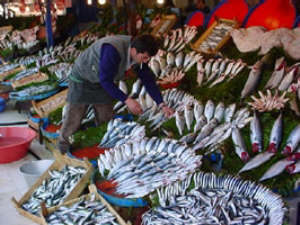
If you have the good fortune to travel in Turkey, you’ll see fish markets like this in every coastal town. The artistry with which fishmongers display their offerings is striking: traditionally, red wooden trays are laid with ferns or other fresh greenery—the better to show off the silvery catch.
Thank you, Tony Nuccio for loaning us this quintessential Istanbul Balik Pazari (fish bazaar) photo. In the foreground, are anchovies, in the middle range, palamut, bonito, with their red gills flipped back to show their freshness. And at the very top, in all their bumpy glory, the most prized of cool season fish—kalkan, turbot—which the Turks like to cut into steaks and deep-fry.
The fish-sellers have age-old street cries, exhorting all pedestrians within ear-shot to examine their stock. Holding up octopus or huge shrimp from the Mediterranean coast near the Syrian border, the vendors appear genuinely distressed if you remind them that you are just a visitor, returning to a hotel room and not strolling back to your own kitchen.
As you might guess, we’re a little homesick. But cooks can assuage those pangs more easily than most. How serendipitous that our Sarasota Vietnamese community has as much yearning for fresh, whole fish as we do. Phuoc Loc Tho on Twelfth Street had some beautiful Florida pompano, Trachinotus Carolinus. Cleaned, but left whole, ours weighed 1.5 lbs., just right for two for dinner. We grilled our pompano alla turca according to the basic Turkish bluefish treatment above.
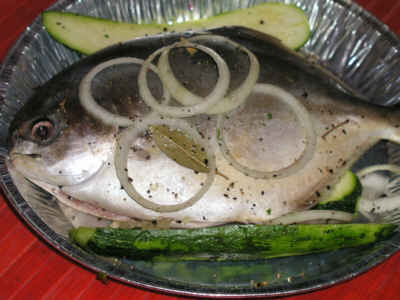
We put the seasoned onion slices and other ingredients inside our fish about 30 minutes before it went on the grill. Served with grilled zucchini and a minted potato salad, it would have pleased the Turks as much as it delighted us.
White Zinfandel Vinegar
May 7th, 2007We had a shop open in downtown Mystic this past summer that, on the surface, seemed a sure hit. A local fellow thought he’d have a go at selling olive oils and vinegars. Of course, I thought this was a great idea too. I had visions of a shop like Alziari in Vieux Nice, where patrons bring their own bottles, and draw off as much olive oil as they need from one of Alziari’s massive vats. Or they bring their own containers and scoop out pounds of Piccholine, Calamata, and Sicilian Colossal olives.
Alas, our young fellow had a different strategy in mind. His turns out to be the kind of shop where Aunt Martha might go to buy a stocking-stuffer for cousin Sally who’s running around with that young Italian fellow. That is to say, a 4 oz. Bottle of olive oil of indeterminate origin that costs around $25.00.
Nevertheless, our local fellow was enthusiastic about his products, and was delighted to organize tastings on the spur of the moment. The day I visited his shop he had several bottles of vinegar on offer; among them, a bottle of White Zinfandel.
I tasted; it was fruity yet acidic; full-bodied yet mellow. I could talk about hints of blackberry, tobacco, and apricots, but the only time I’ve gotten those hints was when I tasted blackberry, tobacco, or apricots. The White Zinfandel was lovely. But at $25.00 for 750 ml. I thought I could do better.
I’ve made my own vinegar in the past. In fact, when I stayed on a vineyard in Piemonte, my host and hostess sent me home with a parting gift of Barolo mother, or vinegar starter. When I got home, I simply found a clean container, added the mother, and poured in bottle of Gallo Hearty Burgundy. Six or eight weeks later, I had some delicious red wine vinegar.
How I Did it This Time
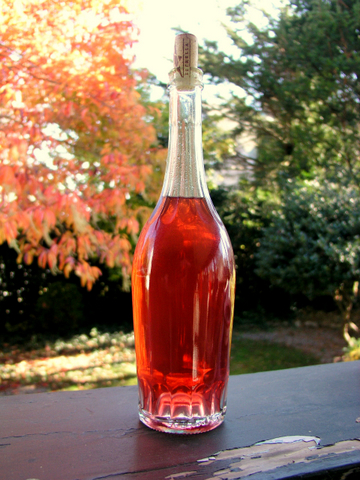
This time, I didn’t have a mother, so I went to a health food store, and bought a quart of unpasteurized, unfiltered cider vinegar. This—I’ve been told—would do the job of turning wine into vinegar. Next, I went to my local liquor mart for a liter of Sutter Home White Zinfandel wine. Finally, I prevailed on a chef friend for an empty glass one-gallon pickle jug, and the use of her Hobart commercial dishwasher.
If you don’t have a chef friend and can’t wash your container at 192 degrees Fahrenheit, scrub your container with detergent, then rinse with a solution of one-tablespoon chlorine bleach to one gallon of water, then rinse again with warm tap water. The whole idea here is that any bugs that show up in the vinegar—and they will—should be yours, and not the previous occupant’s.
To start the process, combine the cider vinegar and the wine in a one gallon container; cover the top with a cloth, like a piece of old bed sheet. Secure the cloth with an elastic band, then store the mixture in a warm dark place. After approximately two weeks, the liquid will appear cloudy, with some milky solids forming at the bottom of the jar. This is the beginning of the mother. After approximately four weeks, the mixture should taste more like vinegar than wine. After approximately six weeks, you should have nearly one and one half liters of vinegar.
When this happened for me, I drew off approximately half of what I had, and replaced it with an equal part of Sutter Home White Zinfandel. The vinegar in the photograph represents the second round of fermentation.
At this point, I’m switching to Champagne vinegar; my friend whom I’ll call Fatima, had a bottle of indifferent German sparkling wine called Trocken that seems like a good candidate.
I’ll get back to you about this effort in about six weeks.
[ad#bottom]
What Would Mama Do?
May 6th, 2007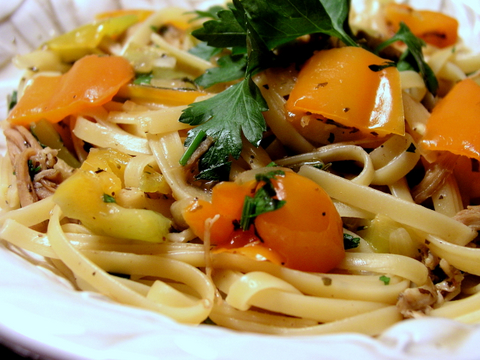
Two evenings ago, Fatima and I cooked Pollo al Forno in Padella, Pan-Roasted Chicken. I would have posted the recipe and a photograph, but it turned out to be brutta ma buona: not all that photogenic, but delicious nonetheless.
As we are only two, we had leftovers from a four-pound bird. So last evening, the burning question around our kitchen was, what to do with some miscellaneous, fully-cooked chicken parts. Of course, I’m on record all over the place as becoming peckish if I go more than a couple of days without pasta, so that seemed a logical choice. But from that point, we asked the rhetorical question, “What would Mama do?” That is, how would the typical Italian mama use leftovers? A visit to the refrigerator seemed in order.
Right away, we found two cubanelle peppers turning from green to orange. Half a Bermuda onion glowed in the vegetable bin. And during the Florida winter, we always have a bouquet of flat-leaf Italian parsley on hand.
Some tempting local plum tomatoes sat on the counter, but we restrained ourselves. Instead, we opted for the leftover pan sauce from the chicken, supplemented by a little meat broth I had made over the weekend.
But I didn’t use just any broth; this was Paul Bertolli’s Meat Broth (Cooking by Hand, page 135).
A Saturday afternoon and 10 lbs. of hefty beef knuckles and shanks, pigs’ feet, and chicken backs had yielded four quarts of liquid amber. So you can understand why we didn’t want too many distracting elements in our dish.
We took the chicken fat from the leftover pan sauce to sauté some garlic, the sliced cubanelles and coarsely chopped onion. While the vegetables sweated, I shredded the remaining chicken, which we put into the pan when the onion had begun to carmelize .
Then we raised the heat to medium-high and added a cup of the chicken pan sauce. As that reduced, we poured in approximately a half cup of the Bertollian meat broth.
Meanwhile, on the back burner, our linguine was now at the al dente state. We drained it and swirled it into the sauté pan along with approximately half a cup of its cooking water.
Just before serving, we tossed in two generous handfuls of coarsely chopped parsley. We finished the dish at the table with a grating of Pecorino-Romano. We think Mama would have been pleased.
Free Lunch?
May 5th, 2007Ever since I moved to Sarasota, I’ve been hearing a joke that goes something like this: “All the old people live in Sarasota.. (beat).. and their parents live in Venice.”
Whether that’s true or not, the numerous opportunities to enjoy an “early bird special” do suggest something about the bedtimes of a large segment of Sarasota’s dining-out population. And although I don’t think of myself as one of those early birds, it was not long ago that the AARP wished me “Happy Birthday.” The snail-mail invitations for no-obligation investment consultations started arriving shortly thereafter.
The financial advisors who really want your IRA and 401K funds are competitive, very competitive. A savvy advisor knows that it takes more than his corporate parent sponsoring a PBS broadcast on the spotted owl to lure clients into his tastefully appointed sanctum.
So, as they look at their working-girl mutual fund portfolios in need of new strategies, my friend Fatima and her circle don’t feel the least bit abashed accepting a few of the many dining invitations extended by investment firms. And in Sarasota’s lively winter season, these invitations are clearly the bait of choice.
The lure of lunch or dinner at one of Sarasota’s A-List restaurants can easily outweigh one’s reluctance to be part of the gracious audience at an investment seminar—even when one is asked to show up for dinner at 3:45 p.m.
Fatima and I recently attended one such “seminar.” The presenter, our dapper host, whom I’ll call Larry, had a PowerPoint presentation and patter that might have been better suited to selling resort time-shares (and indeed he made a joke about time-shares). Larry made a lot of jokes—starting with, “Ok, how many of your came to this thing for the food?” A few guys just off the golf course raised their hands.
But business is business, and Larry got right down to the equities market, its inherent uncertainties and what he and his team could do to “lock in gains.” Larry dressed as if he’d locked in quite a few gains himself, an ample waistline hardly detracting from his crisp Euro-blue shirt, the sort I’ve always wanted—with the white collar and cuffs. Fatima reminded me that I should continue to maintain my literary integrity and dress like an English-major: that is, stick with the L.L. Bean oxford button downs I’ve been wearing since high school.
I found it easier to swallow actuarial tables and hedging strategies than the fact that someone selling annuities, had not double-checked the pronunciations of certain key words: With absolutely no irony, Larry spoke of need to be “vil-uh-gent” so as to guarantee returns to one’s “bene-foo-ciaries.”
Meanwhile, two waiters had begun to pour generous glasses of either Babcock Cabernet Sauvignon, or Los Alamos Chardonnay to an audience of forty in the restaurant’s private dining room.. At the same time, Fatima and I passed notes back and forth about whether one of the four single women at our table might be a shill for the firm.
I can happily report that our concern about a shill in our midst was unfounded, and that our food—served after roughly 80 minutes of “pitch”—was excellent. Larry was keeping his side of the bargain.
The restaurant had offered five choices, drawn directly from their evening dinner menu (one poultry, two fish, and two red meat dishes). The platings were attractive, but we agreed that sides and garnishes would have been more elaborate at a prime-time 8:00 seating.
My braised lamb shank was enormous—tender, juicy, and falling from the bone. Fatima’s red snapper, accompanied by a chunky fresh chutney, was delicious. One of our table-mates pronounced her filet mignon appropriately well-seared and rare in the center.
The single dessert offered came as soon as each guest’s main-course plate had been cleared, a reminder that the waiters would soon be needed in a higher hospitality mode in the main dining room. The homey apple crisp with cranberries, and walnuts was very good but would have benefited from a warmed sauce or a small amount of ice cream. (Indeed, it is offered à la mode on the printed menu.)
Continuing to note potential differences from the 8:00 seating, we couldn’t help notice that our coffee, an excellent brew poured from small air-pots at the table, went into cups that had arrived without their saucers. Our slightly distracted server seemed to have a small problem distinguishing the decaf from regular. At a function like this, the waiters know that their gratuity will come from the host, not the diners they serve. Consequently, there is little need for them to hover or utter the perfunctory, “How is your meal, sir?” Even as reviewers, we can’t say that we had a sense of evening service style. This was, after all, the proverbial free lunch.
You might well ask if I have the temerity to rate a restaurant on the basis of a banquet-service meal. The unequivocal answer is no. What we experienced was very good food, but not all the components that create the ambience a fine restaurant seeks to project. The buzz of a successful restaurant with competent staff and a clientele anticipating pleasure are among the intangibles that contribute to memorable meals.
On balance, I think our meal trumped the presentation, and I would willingly consider annuities and IRA-rollover plans again. And the next time, a presenter suggests “getting into equities,” I’ll be able to ask if he’d recommend that I hedge my portfolio by purchasing a “corresponding put.” More importantly, I’d be willing to return to this restaurant and give it a legitimate review.


